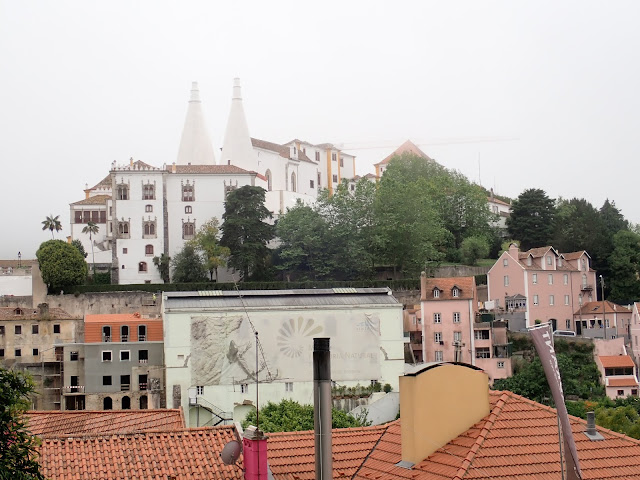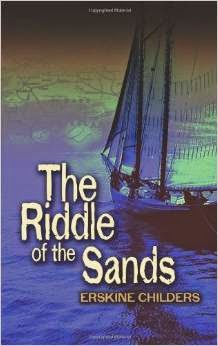 |
| The Palatio National da Sintra seen from the park side |
We rented a car for the day and invited our friend Scott, a Californian who bought a catamaran in Connecticut and sailed it to Cascais via the Azores with a professional skipper, to join us for a day trip to Sintra. The forecast was for beautiful weather - moderate winds and a few high level clouds. It's only 30 minutes' drive to Sintra but taking a bus would have taken more than an hour. So we thought we'd make a day trip out of it. We weren't sure what to expect, but Noelia at MRCYB has recommended it as a must do in Portugal.
The drive there was uneventful and Mrs. Google Maps gave us good directions. The highway was pretty awful, with lots of graffiti and derelict buildings along the way. The rest was postmodern architecture. When we arrived in Sintra, it was not much better. What we saw of the town on arrival did not bode well. We parked at the train station outside of town and walked in. Whereas it had been warm and sunny in Cascais, here it was cool and grey, with low cloud and mist. We started walking toward what we thought might be the old city centre. More derelict buildings and a few cute and whimsical ones. Many Tuk Tuk tourist vehicles accosted us along the way but one stood out. A woman in a flashy Tuk Tuk called out to Alex, "Hey you want to have the best day of your life?" He said, "Hmm, I'll have to think about that one."
We came upon a park in a gully and asked directions, learning that we were indeed heading the right way. All along the parkland walkway and road were artworks, and a museum was at the base of the gully. Along the wall, craftspeople and artists were displaying their wares.
We could see the distinctive twin peaks of the national palace and headed in that direction. Suddenly we were in a square surrounded by shops and restaurants facing the palace, which itself was unremarkable in design. We got a map at the tourist office and quickly realized that Sintra is a centre of ostentatious living. There were palaces in every direction. Little streets wound up hillsides and on each was a bewildering array of tsyatchka, pottery, and port shops. I stopped to buy a lizard for our door at home and asked the young man what he would recommend seeing first. He answered without thinking, "The Palacio de Regaleira. It is most magical". As it was a short walk away, we decided to take his word for it.
We weren't quite prepared for what we found. The house was interesting but it was the grounds that were astounding. Paths meandered through gardens above and under ground. Everything was decorated with intricate masonry, with wells and seating built into many outcroppings. But it didn't feel OTT or distasteful - not like a Trump OTT monstrosity. There were follies galore - charming ones. A tennis court with alcove and observation towers. Mysteriously, an 'initiation well' has a spiral tower leading out and tunnels leading in. The man who commissioned the place was a wealthy industrialist who hired an Italian designer to build the house and chapel for him. It was built in 1909 so it wasn't that old. We'd thought it was ancient. He was apparently into masonic rites and occult rituals and there are signs built in throughout. Fascinating place.
We had lunch in a lovely tapas & wine restaurant,
Tascantiga, off the beaten path. I'd seen a sign, "If you want real Portuguese food, come here." It was a lovely, whimsical place with good food and good vibes. Lots of locals eating there, always a good sign.
The town had a fascinating feel of Moorish, Gothic and Portuguese revisionist influence. The Moors arrived in the 1500s or thereabouts and built fanciful structures with painted turrets. The wealthy families that flocked to Sintra over the centuries included royals, adventurers, and industrialists, each trying to outdo the other in opulence. The land is rather hilly, and the tops of the sharpest peaks are covered in castles and palaces that look like they are straight out of a fairy tale book. It is a most magical place, with castles appearing out of the mist like they do in dreams.
We decided to get the car and do a road trip to the Palacio da Pena, supposed to be the most splendid living quarters in the world. The royal family had done it up in the 1800s for their summer residence. The Castelo dos Mouros was on the way. OMG the road there was the most twisty turny tiny road ever, heading straight up the mountain and into the clouds. We had like zero visibility when we arrived at the moorish castle. We decided to bag it. The grounds were not visible and the palace would be full of buss loads of tourists. So back out the other end of the road - fortunately it was a one way system - along with the buses and tut tut tour trikes.
Scott wanted to head back for a siesta and I was tired too. It was now about 4 pm. But we made a stop at Europe's westernmost point at Cabo da Roca. The wind was gusting fiercely, blowing bands of mist across the trail. The lighthouse looked bleak and the wind was sweeping people off their feet. I didn't want to come anywhere near the edge for risk of being swept off into the abyss. Where did this weather come from? It was not forecast.
We took a few quick pictures and watched the clouds envelop the land. Back home t was, only 30 minutes' ride away. As we approached Cascais, the blue sky opened up and the wind abated. But soon the clouds and mist followed us home. The Jumbo was jamming with people stocking up for the big game - Portugal was playing Spain in the first round of the FIFA championships. Big game. Crowds gathered around televisions everywhere, and roaring throughout the marina. (I found out in the morning, the match ended in a 3-3 tie. Must have been exhausting to watch.)
All night the wind howled through the marina. Halyards banged and a sail got shredded. I slept through it all. Not a cough all night.
 |
| Moorish influence in architecture |
 |
| Carriage rides for sightseeing |
 |
| Whimsy |
 |
| Art all along the park walkway |
 |
| Palacio National |
 |
| Old town centre |
 |
| Alex and Scott |
 |
| Alex with cloud descending behind |
 |
| Walking to the Palacio e Quinta de Regaleira |
 |
| Discussing one of the many follies |
 |
Secret entrance to the tunnels |
 |
| Underground tunnel to the Initiation Well |
 |
| Spiral staircase leading up from the well |
 |
| Alex walking up the stairs |
 |
| Another folly |
 |
| Dragons adorn a fountain and hidden bath |
 |
| The unfinished well |
 |
| A grand folly near the entrance to the house - the M logo for Monteiro |
 |
| The house of Monteiro |
 |
| The chapel |
 |
| Inside the chapel designed and created in Italy |
 |
| Hunting scene stained glass window |
 |
| Masonic symbol |
 |
| View from the choir loft |
 |
| Window in the loft. Glass in the middle did not look as It does in the photo. |
 |
| Carved ceilings in the house |
 |
| View of the gardens from the dining room |
 |
| Narrow cobbled streets of Sintra |
 |
| Port wine shops everywhere |
 |
| Pottery, tiles and linens |
 |
| Lots of climbing in Sintra |
 |
| Alex and friend |
 |
| Lighthouse at Cabo de Roca |
 |
| Getting blown away by intense gusts of wind |
 |
| The westernmost point in Continental Europe |







































Comments
Post a Comment